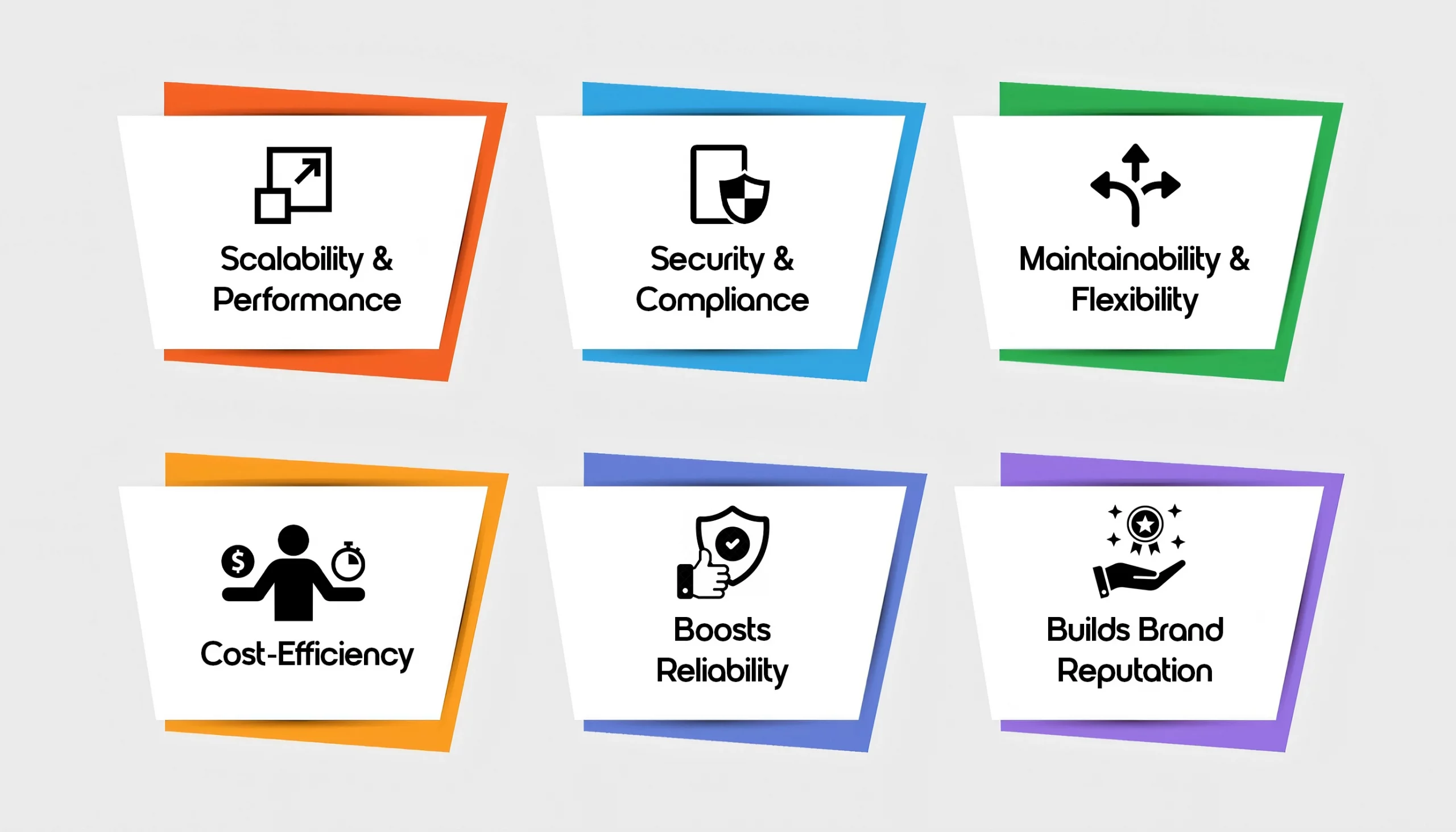Suppose you have a brilliant business idea and are ready to launch a web-based platform to bring a huge change in the industry. You try every possible way to invest in making it visually appealing and incorporate features & functionalities and top-notch security. But then suddenly your website crashes due to very high traffic or load or it becomes vulnerable to cyber threats. Of course, you will try to figure out what went wrong. The secret to a seamless, high-performing website lies in web application architecture.
It acts as the backbone that dictates how your web app functions, scales, and secures user data without any technical glitches. If your website does not have a robust architecture, even the most innovative web applications can fail.
So, if you are an entrepreneur, you need to understand what web application architecture is, why it matters, different types, key components, and best practices to build a scalable and secure application.
By understanding all these aspects, you can easily revamp your digital infrastructure. Till the end of this blog, you will get to know how to choose the right architecture for long-term success. So, let’s get started:
Table of Contents
What is Web Application Architecture?
Web application architecture is the structural blueprint of how a web-based application operates. Moreover, it also determines how various components—such as databases, servers, front-end, and back-end communicate and work together.
To understand it in simple terms, web application architecture ensures the following:
- Smooth data flow between the client (user interface) and the server (backend logic).
- Efficient processing of user requests.
- Security mechanisms to protect sensitive data.
- Scalability to handle increasing user traffic.
Modern web applications rely on various web-based application architectures depending on specific business needs and scalability requirements. You can also partner with a leading full stack development company as they have in-depth knowledge & experience and will ensure your web-based app runs smoothly without any glitches.
Why Web Application Architecture Matters for Your Business?

A well-designed web application architecture is much more than just coding. It is one of the best strategic decisions that can directly impact the overall business growth and user experience. Here we have mentioned some valid reasons that showcase why web application architecture is crucial for your business:
1. Boost Performance and User Experience
If you have a poor architecture of your web-based app, it can cause slow load times and system crashes. On the other hand, having a scalable web app architecture ensures smooth operation even during traffic spikes. However, you need to work with an industry expert to enhance the overall performance of your web application.
2. Strengthens Security and Data Protection
Strengthening security is a critical aspect of web application architecture, and leveraging advanced testing methodologies can greatly minimize vulnerabilities. For an in-depth understanding of modern techniques, a deep dive into IAST for web application security explores how interactive application security testing enhances protection beyond traditional approaches.
3. Improves Business Agility and Innovation
A well-structured web app architecture allows easy updates, bug fixes, and feature enhancements. Business owners who are future-proofing their web applications means that they are adapting to cutting-edge technologies. This can give you a chance to stay ahead of your competitors.
4. Reduces Maintenance Costs and Complexity
Poorly designed web-based applications require frequent troubleshooting and costly fixes. With the help of cloud-based AWS architecture for web applications, you can easily optimize resource usage which also helps you to reduce expenses.
Additionally, by investing in the right web app architecture strategy, businesses can enhance reliability, security, and user satisfaction while minimizing downtime and operational costs. So, you must invest in it to save your costs in the long run.
5. Boosts Reliability and Uptime
Downtime can lead to revenue loss and damage brand reputation. A robust architecture for web applications ensures high availability through multi-region deployment, real-time monitoring, and disaster recovery strategies. Therefore, it keeps your business operational 24/7.
6. Builds Customer Trust and Brand Reputation
A well-architected web application delivers a secure, fast, and seamless experience. With reliable performance and data protection, users trust your platform even more. Therefore, it leads to higher retention rates and a stronger brand reputation.
Types of Web Application Architectures
Business owners need to choose the right web application architecture to ensure performance, scalability, and security. Here are the key types of web-based application architectures that businesses can consider:
1. Monolithic Architecture
A monolithic architecture is seen as a unified, cohesive application with closely integrated database, business logic, and user interface components.
- Best for: Small projects and startups that need quick development.
- Pros: Simple deployment and lower initial costs.
- Cons: It is challenging to update, scale, or modify certain parts of the system without affecting the system as a whole.
2. Microservices Architecture
With this architecture, an application is separated into independent services that interact with one another via APIs. More flexibility is made possible as each service manages a specific function.
- Best for: Complex, large-scale applications that need to be scalable.
- Pros: Individual services may be easily scaled, updated, and maintained without interruption.
- Cons: Needs robust API management and a more complicated web application development.
3. Progressive Web Application (PWA) Architecture
PWAs deliver a native-like experience on browsers and integrate the finest features of mobile and web apps.
- Best for: News portals, e-commerce, and applications with a lot of content.
- Pros: Enhances user engagement, works offline, and loads quickly.
- Cons: Compared to native mobile apps, there is less access to device hardware.
Read More: Progressive Web App vs Website: Which One Suits Your Business Needs?
4. Serverless Architecture
Developers solely concentrate on creating code in serverless AWS web application architecture, where the server infrastructure is managed by the cloud provider (AWS, Azure, Google Cloud).
- Best for: Startups, cost-conscious businesses, and apps with varying traffic.
- Pros: Scales automatically and lowers infrastructure expenses.
- Cons: Vendor dependence and little control over backend processes.
Read More: AWS vs Azure vs Google Cloud Platform (GCP): Which is best for your business?
5. Hybrid Architecture (Combining Multiple Models)
Some businesses adopt a hybrid approach that combines microservices, serverless, and SPAs and offers a highly flexible and scalable system.
- Best for: Businesses that need both scalability and high performance.
- Pros: Tailored solutions optimized for business needs.
- Cons: Requires expertise in multiple architectures and careful integration.
Note: Businesses must note that choosing the right web app architecture depends on various factors such as business needs, user expectations, and future scalability. The above are some of the popular web application architecture types. To know which one suits best for your business needs, you can contact industry experts.
Key Components of a Robust Web Application Architecture
A well-built web application consists of several key components that ensure smooth operation. For your better understanding, we have mentioned a few of them below:
1. Client-Side (Front-End)
- Technologies: HTML, CSS, JavaScript, React, Vue.js
- Handles user interactions and UI rendering.
2. Server-Side (Back-End)
- Technologies: Node.js, Python, Java, Ruby on Rails
- Processes user requests and manages business logic.
3. Database Management
- Database for web applications are SQL (PostgreSQL, MySQL) or NoSQL (MongoDB, Firebase)
- Stores and retrieves data efficiently.
4. Web Application Firewall Architecture
- Protects against cyber threats like SQL injection, and DDoS attacks.
- AWS WAF is a robust option for AWS web application architecture security.
5. Load Balancer
- Distributes user traffic across multiple servers for reliability.
- AWS Elastic Load Balancer optimizes AWS architecture for web applications.
6. Caching Layer
- Technologies: Redis, Memcached
- Stores frequently accessed data to reduce server load and boost speed.
Read More: Why Choose React for Web Development- Features & Reasons?
Choosing the Right Web Application Architecture for Your Business
Business owners who do not have technical knowledge may find it difficult to select the right architecture. However, choosing the right one depends on the following factors:
1. Business Size & Growth Plans
Startups may begin with a monolithic architecture. However, as they scale up, microservices or serverless models may be more beneficial.
2. Traffic Volume & Performance Needs
If your business has a high-traffic application, it may require load balancing and cloud-based AWS web application architecture.
3. Security Concerns
Industries like finance and healthcare need advanced web application firewall architecture for data protection. The main reason is that it enhances the safety & security of sensitive data.
4. Budget Constraints
Serverless architecture reduces infrastructure costs, while traditional models require investment in dedicated hosting. That’s why, you need to choose the web application architecture wisely to save your cost.
5. Technology Stack Compatibility
Choosing the right full stack web development technologies ensures seamless integration and future-proofing.
Best Practices for Implementing a Web Application Architecture
To build a fully successful web application, you need to follow the below-mentioned practices:
- Design for Future Growth & prioritize Scalability – You can design for future growth, using cloud solutions like AWS architecture for web applications. Also, you can prioritize scalability by using cloud solutions, implementing load balancing, adopting microservices, etc.
- Protect Your Data & Users – You can implement web application firewall architecture to prevent cyber threats and secure your data. You can also follow the best security practices such as implementing a web application firewall, using secure authentication, regular security audits, and data encryption and access control.
- Optimize Performance and Speed Matters – Users expect fast and smooth web applications. If your website loads slowly, it can lead to high bounce rates and lost customers. So, to optimize business performance, you can use caching, load balancing, and database indexing.
- Adopt a Modular Approach –A modular architecture ensures your web application remains adaptable and easier to maintain. Microservices and API-first strategies allow flexibility.
- Monitor & Maintain-Stay Ahead of Issues – A web application is never truly done, it requires continuous monitoring and regular maintenance to ensure stability. You can use real-time monitoring tools for uptime and error detection.
- Leverage DevOps & CI/CD – Modern web applications require fast, reliable deployment cycles to push updates and fixes seamlessly. Automate deployment and testing for continuous improvements.
Conclusion
Your web application’s success depends on choosing the right architecture. You should choose a web application architecture that balances performance, security, and scalability. Whether you opt for a monolithic, microservices, or AWS web application architecture, a well-structured web application architecture enhances user experience, boosts efficiency, and protects valuable data.
Investing in the right web-based application architecture has also become a necessity for thriving in today’s digital landscape. So, by implementing best practices and leveraging cutting-edge technologies, you can build a future-ready web application that stands out in the competitive market.
FAQ’s
1. How does a web application firewall architecture enhance security?
A web application firewall (WAF) protects your website from various cyber threats like DDoS attacks, SQL injection, and cross-site scripting (XSS). It protects your website by filtering and monitoring traffic between users and the application.
2. What is the role of AWS in web application architecture?
AWS architecture for web applications provides cloud-based infrastructure. It includes scalable hosting, databases, load balancing, and security solutions like AWS WAF. Therefore, making web apps more resilient and cost-efficient.
3. How can I choose the right web application architecture for my business?
The right architecture depends on various factors like business size, scalability needs, security concerns, budget, and traffic volume. For startups, a monolithic approach may work initially, while large enterprises benefit from microservices or serverless models. However, if you are not sure which architecture is most ideal for your web-based app, you can seek help from top-rated Full Stack app development companies.
4. How do I ensure my web application architecture is scalable?
Implementing load balancing, caching strategies, microservices, containerization, and serverless computing ensures your web app can handle increasing user traffic.










 India
India USA
USA Australia
Australia Canada
Canada UK
UK UAE
UAE
